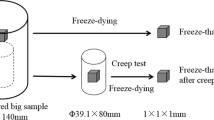Abstract
Artificial freezing is becoming a common method of enhancing soil quality when undertaking large scale underground structures in Shanghai. This paper presents the variation in the frozen strength of Shanghai muddy clay with temperature. SEM studies were undertaken to analyse the shape and size of the pores in the frozen material compared with the undisturbed clay. The results show that compared with undisturbed soil, the shape and the orientation of the pores in samples frozen at −10, −15 and −20°C did not significantly change after the compression testing, although the pore volume increased with decreasing temperature. The relationship between microstructure and moisture migration is discussed.
Résumé
La congélation des sols devient une technique usuelle pour améliorer la résistance des sols pour des travaux souterrains importants réalisés à Shanghai. L’article présente l’évolution, en fonction de la température, de la résistance de sols argileux gelés. Des études au microscope électronique à balayage ont été réalisées afin d’étudier la forme et la taille des pores d’échantillons congelés, par comparaison avec des échantillons intacts. Il apparaît que la forme et l’orientation des pores d’échantillons congelés à des températures de −10, −15 et −20°C ne changent pas de façon significative après les essais de compression, bien que le volume des pores augmente quand la température décroît. Les relations entre la microstructure et les phénomènes de migration des molécules d’eau sont discutées.






Similar content being viewed by others

References
Casagrande A (1932) The structure of clay and its importance in foundation engineering. J Boston Soc Civ Engris 19(4):168–209
Cheng XS (1991) Experimental study on instantaneous unconfined compression of manually frozen soil (in Chinese). Well Constr Tech 6:76–81
Goldschmidt VM (1926) GeochemischeVerteilungsgesetae,VII: Die Gesetze der Krystallochernie (nach Untersuchungen gemeinsam mit T. Barth, G. Lunde, W. Zachariasen);Skrifer Nersk. Vid. Akademie, Oslo, Mat. Nat. Kl. 1926. No. 2; See in addition VIII:Untersuchungen uber Bau und Eigenschaften von Krystallen, l.c. No. 8.
Li L (2001) Studies of microstructures of soft soil from the Pearl River delta by means of SEM (in Chinese). Acta Scientiarum Naturalium Universitatis Sunyatseni Natural Science 40(4):102–106
Osipov VI et al (1979) Physico-chemical approach in studying the mechanical properties of clay soils. Engineering Geology, Bull. USSR Ac. Sc: 4
Qi JL, Xie DY (2000) The pore size distribution curve and its application in soil structure analysis (in Chinese). J Xi’ Highw Univ 20(2):6–9
Qu JJ et al (2007) An experimental study of the mechanisms of freeze/thaw and wind erosion of ancient adobe buildings in northwest China. Bull Eng Geol Environ 66(2):153–159
Shen F (2005) Study on the freezing construction of the pass way in the tunnel and engineering properties of the frozen and melted soil in Shanghai (in Chinese), Department of Geotechnical Engineering. Tongji University, Shanghai
Shi B (1995) Quantitative approach in SEM images of microstructure of clay soils (in Chinese). Science in China. Series B 38(6):741–748
Shi B (1997) A simple quantitative analysis method for microstructure of clayey soil (in Chinese). Hydrogeol Eng Geol 20(6):7–10
Shi B et al (1999) Preparation of soil specimens for SEM analysis using freeze-cut-drying. Bull Eng Geol Environ 58(1999):1–7
Tang YQ et al (2007) Microscopic study of dark green silty behavior after melting (in Chinese). J Tongji Univ (Nat Sci) 35(1):6–9
Torrance JK et al (2008) X-ray computed tomography of frozen soil. Cold Reg Sci Technol 53(1):75–82
Tovey NK (1973) Quantitative analysis of electron micrographs of soil structure. Proceeding in the international symposium on soil structure, Gothenburg, Sweden, pp 50–59
Tovey NK (1990) A digital computer technique for orientation analysis of micrographs of soil fabric. J Microscopy 120:303–315
Tovey NK, Krinsley DH (1992) Mapping of the orientation of fine-grained minerals in soils and sediments. Bull IAEG 46:93–101
Xu XZ et al (2001) Frozen soil physics. Beijing Science and Technology Press, Beijing
Yang TL, Gong SL (2010) Microscopic analysis of the engineering geological behavior of soft clay in Shanghai, China. Bull Eng Geol Environ. doi:10.1007/s10064-010-0305-z
Acknowledgments
This investigation was supported by the Chinese National Natural Science Fund, Project NO. 41072204, and Shanghai Leading Academic Discipline Project, Project No.B308, and Kwang-Hua Fund for College of Civil Engineering, Tongji University. The authors are deeply indebted to the three financial supporters.
Author information
Authors and Affiliations
Corresponding author
Rights and permissions
About this article
Cite this article
Tang, Yq., Zhou, J., Hong, J. et al. Quantitative analysis of the microstructure of Shanghai muddy clay before and after freezing. Bull Eng Geol Environ 71, 309–316 (2012). https://doi.org/10.1007/s10064-011-0380-9
Received:
Accepted:
Published:
Issue Date:
DOI: https://doi.org/10.1007/s10064-011-0380-9



